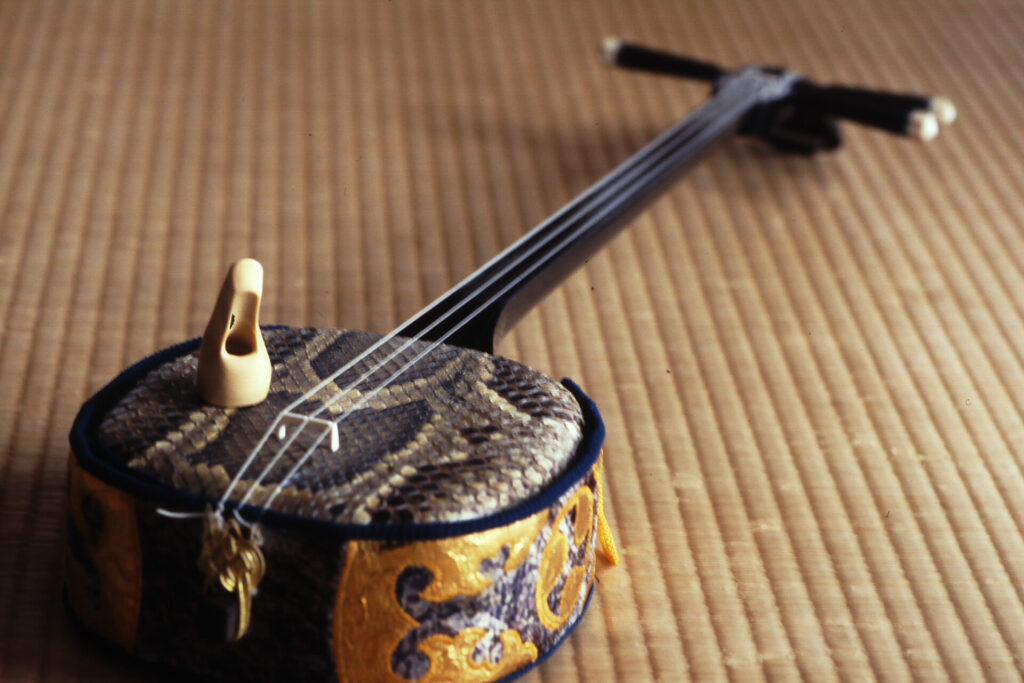Sanshin

“Senpai1, my dog is gone…”
In the dead of the night, I received this call from Kinjo Tetsuo.
We were film screenwriters, and I was a senior to him. Shortly after this call, Tetchan2 breathed his last.
I met Kinjo before the reversion, when I heard the true tone of a sanshin for the first time.
“It’s somehow sad, but when you listen closely to it, it’s great. Isn’t it?”
I nodded, speechless, at his words.
Since then, I went out drinking with Kinjo to talk far into the night every time I visited Okinawa. He was sturdily built with a strong chest but smiled like a boy. I’m sure he was the first to come up with the idea of Ultraman. His existence should be inscribed in the records of Tsuburaya Productions3.
He taught me about what Okinawa is, and the spirit of the Uchinānchu (Okinawan). I also heard from him about the origins of sanshin, that it came from China in the 14th century.
I did some research based on what he told me and found out that it was brought to Okinawa in 1392 when some Chinese settled in a place where it became the Kume Village in the later days. In 1402, according to some documents, the sound of sanshin was heard from a Ryukyuan ship that drifted ashore at Mutsunoura, Musashi4. The sanshin from China, the craze for Buddhism that peaked in the 15th century in Okinawa, and the Japanese texts and poems brought by Buddhist monks: we can say that these altogether let the sanshin create its unique scale, and take hold as an accompaniment. The origin of ryūka (Ryukyu poems) seems to lie in where China and Japan have merged. The short poems in Japanese literature must have given birth to their characteristic melody. Sanshin spread to all the outliers from the main island of Okinawa. Each individual sang songs of joys and sorrows of the nature and the climate of this southern land and sea, impromptu, just letting their feelings flow. The tradition continued through the U.S. rule down to the present day. While Japanese waka poetry consists of 5-7-5-7-7 syllables, ryūka consist of 8-8-8-6 syllables. Kinjo longed to find the answer to this mystery, however, it remains unfulfilled.
Twenty-two years ago, with an assumption that the sanshin must have been carried along the Kuroshio Current and ended up as Tsugaru shamisen5 in Aomori, I did some shooting. That was when I learned that “三絃” were the correct characters for sanshin6. I also encountered the music of Kadekaru Rinsho, famous for his Kadekaru Bushi (Song of Kadekaru), and was totally carried away. His masterly improvisation and tone; it must have been the breath of Okinawa itself. After the defeat in the War, Okinawan people made kankara (can-made) sanshin out of empty cans and parachute strings—I felt that this indomitable mind is where lies the spirit of Okinawa and the essence of sanshin. Kinjo’s words about the greatness in the sadness of a sanshin came back to me. Its high-key melody carried in itself a wondrous power, with its sound seeming like a sobbing cry, but an extreme shout as well.
“The ebony of Yaeyama is the best for the sao (neck), but lumbering is prohibited actually, so Philippine wood is used instead. The skin for the dou (body) is Thai python. We put the head skin of a python on the dou made of keyaki wood. For the tsume (pick), a water buffalo’s horn is the best…,” these are all that Kinjo taught me.
In the Amami Islands where Kinjo took me, I heard that sanshin is played with thin bamboo bachi (plectrum), plucked up and down and beaten out, merging along the chijin drums, adding to the awamori kick.
I just wish you’d come back again, you know, Tetchan.
Editor’s Note:
- A Japanese word calling on a senior.
- A nickname for Tetsuo.
- The production studio of Ultraman.
- Today’s Tokyo, Saitama, and some parts of Kanagawa prefecture.
- A three-stringed musical instrument traditional to the Aomori region in mainland Japan.
- Usually written “三線”.









































































































































































































































